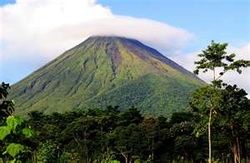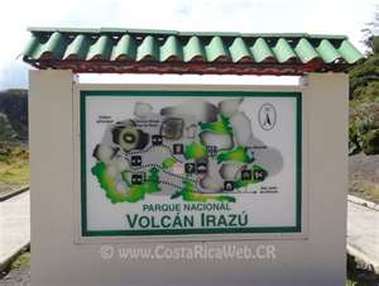Irazú Volcano National Park

Irazú Volcano National Park, or in Spanish the Parque Nacional Volcán Irazú, is a National Park in the Central Volcanic Conservation Area of Costa Rica that encompasses the area around the Irazú Volcano in Cartago Province which incorporates what used to be the Ruben Torres Rojas Forest Reserve now called the Prusia Forest Reserve. The volcano is still active although the last major eruptions were between 1963 and 1965, with occasional minor eruptions and some small lava flows since that time.
The park is the site of a reforestation project to restore the area which was destroyed by the eruptions. The forest is made up of conifers and other exotic and native species and also a native forest consisting mainly of oaks and alder, protecting the watershed of the Reventado River. The Crater Principal lake has an unusual greenish yellow coloring caused by rainfall dissolving the minerals along the craters walls. It has also been known to change colour to rust-red depending on the minerals present. The inactive, dry Diego de la Haya crater sits just up to the right of the Crater Principal and is filled with volcanic ash. |
Back to National Parks
|
-
Major Beaches by Zone
-
Hotels and Restaurants
-
Costa Rica Info
- About Costa Rica
- Costa Rica Map
- Festivals of Costa Rica
-
Costa Rica National Parks
>
- Arenal National Park
- Barbilla National Park
- Barra Honda National Park
- Braulio Carrillo National Park
- Cahuita National Park
- Carara National Park
- Chirripo National Park
- Cocos Island National Park
- Corcovado National Park
- Diria National Park
- Guanacaste National Park
- Irazu Volcano National Park
- Juan Castro Blanco National Park
- La Amistad International Park
- La Cangreja National Park
- Las Baulas National Marine Park
- Manuel Antonio National Park
- Maquenque National Park
- Palo Verde National Park
- Piedras Blanco National Park
- Poas Volcano National Park
- Rincon de la Vieja Volcano National Park
- Santa Rosa National Park
- Tapanti National Park
- Tenorio National Park
- Tortuguero National Park
- Turrialba
- Typical Questions
- International Air Service
- Costa Rica Domestic Air Travel >
- Driving in Costa Rica >
- U.S. Embassy Notices
- Costa Rica Properties
- Community Service
- Costa Rica Golf
- Monteverde Tours
- Costa Rica News
- New Page


